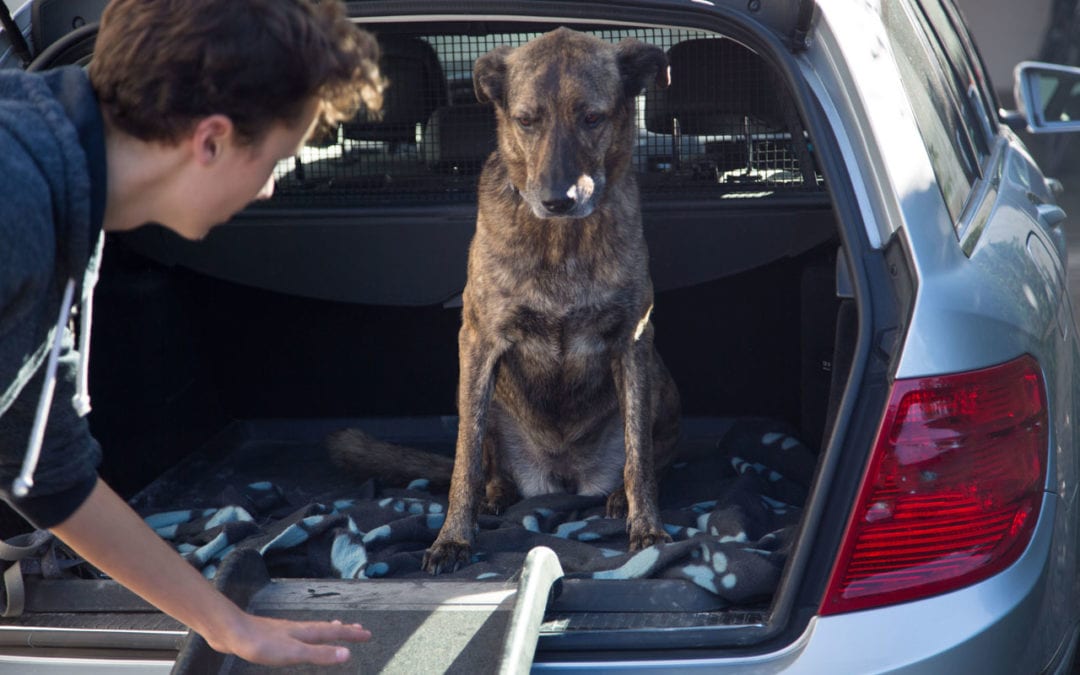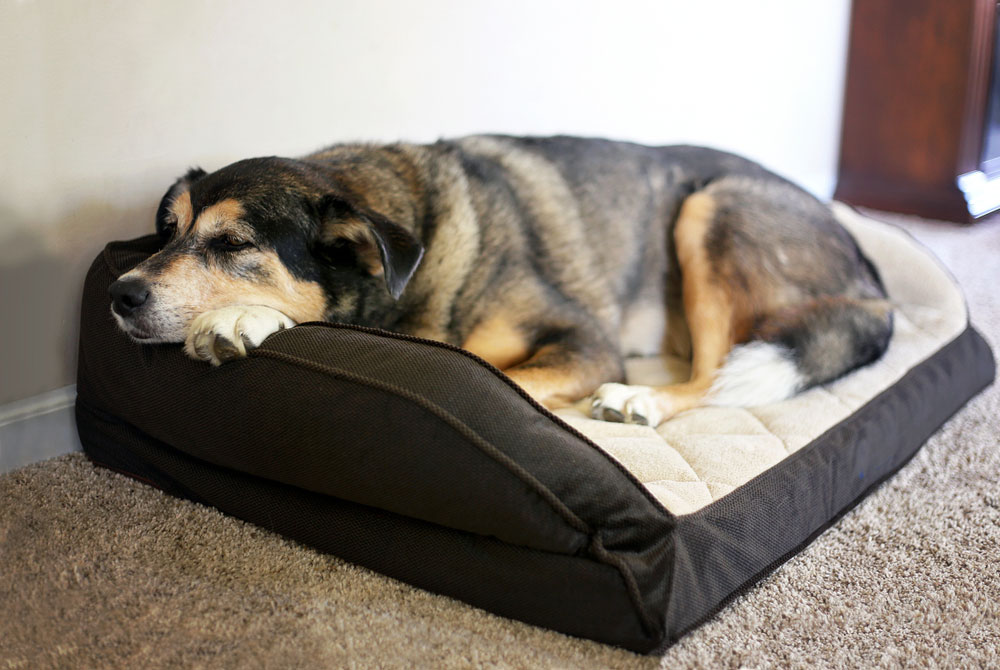Our Veterinary team put together this guide to arthritis in dogs and cats. Our aim is to give pet owners a better understanding of this common disease affecting our fur friends.
Thanks to advances in veterinary medicine and nutrition, our pets are living longer, fuller lives. It’s not uncommon to see cats and dogs living into their geriatric years with good health and vitality. While our pets are living longer lives, many common conditions can still affect them in their later years.
Arthritis is a condition generally associated with aging in humans but it also affects our dogs and cats. Older pets are more likely to have arthritis than young pets. The cause is usually a previous injury that caused joint damage. As your pet ages, inflammation aggravates the old injury plus progressive degeneration of the joint. The result is pain.
Osteoarthritis (the most common form of arthritis) can vary in its location in the body and its initial cause. For that reason, treatment plans can vary widely between pets.
Arthritis in Dogs and Cats
Arthritis is an inflammation of the joints. It can affect one joint or multiple joints. Arthritis is very common in dogs: one in five dogs will experience this condition in their lifetime. An estimated 12 million cats will also have a joint degenerative condition. Veterinarians diagnose arthritis most frequently in senior dogs and cats, and it is much more likely to occur in pets over the age of 10.
Arthritis is a general term for when the joints have abnormalities and the cartilage between the joints progressively wears away. The cartilage is a cushion that protects the joints during movement. Over time, this degeneration causes discomfort and pain. That pain can impact mobility and lead to lameness when left untreated.
What Causes Arthritis?
For most cats and dogs, arthritis develops as a result of joint damage that causes joint instability. One of the more common dog injuries is a CCL (cranial cruciate ligament) rupture. This injury is a tearing of an important ligament in the knee joint which results in partial or complete joint instability, lameness, and pain. Other trauma and injuries, such as fractures, can eventually lead to arthritis as well.
Sometimes joint abnormalities start at birth or during a pet’s developmental stages and progress over time. Joint instability can result from other common joint problems as well, which are also closely related to progressive arthritis.
- Hip dysplasia is when there is an abnormal function of the hip socket.
- Elbow dysplasia can occur in the first year of life when the bones are developing. This happens more to larger breed dogs.
- Patellar luxation is one of the more common conditions affecting toy breeds, causing the patella, or knee cap, to come out of its groove. In its more serious stages, we often recommend surgery.
Untreated infection after an injury can cause arthritis. Certain autoimmune disorders (that are rare in pets), such as lupus and rheumatoid arthritis can also lead to arthritis. Cartilage abnormalities, like osteochondrosis dissecans (OCD), cause thickening of the cartilage and increased risk of injuries which also leads to arthritis.

Signs of Arthritis in Dogs and Cats
Have you noticed that Bella isn’t running around the room like before, or that Milo isn’t as eager for those morning walks? Or maybe you’ve witnessed your pet walking stiffly. You’re probably familiar with an older friend or relative who has arthritis and have seen how it changes their activity and mobility. It is similar for our dogs and cats.
Arthritis impacts both cats and dogs, but sometimes the location of arthritis varies between the two species. Among dogs, arthritis mostly affects the hips, elbows, shoulders, knees, wrists, ankles, and spine. Arthritis among cats most affects the shoulders, hips, elbows, knees, and ankles.
If your pet is gradually slowing down or moving awkwardly, it is likely an indicator of arthritis. That’s especially true if your pet is in their senior years or has experienced an injury at some point in their life.
Symptoms of Arthritis in Dogs and Cats
Common symptoms of arthritis in dogs and cats include:
- Limping or favoring one side of the body or leg
- Difficulty moving, stiffness
- Fatigue
- Disinterest in exercise
- Failure to use the litterbox
- Aversion to handling
- Muscle atrophy
- Swelling in the joints
- Licking or biting affected area
- Irritability or aggression
- Seeming to be in pain
Arthritis can be painful and debilitating, and the pain will increase as the condition progresses. Be sure to follow up with your veterinarian or specialist if you notice any changes in how your pet behaves or is able to move.
Complications of Arthritis
Osteoarthritis can be very painful. Along with pain, a pet may experience a decreased quality of life. Over time, your dog or cat may not be able to do certain exercises or activities anymore. That can lead to frustration and personality changes.
If your pet cannot exercise or be mobile, health problems also arise, including the risk of obesity. Obesity then brings with it an increased risk of diseases like heart disease, liver disease, and diabetes. The extra weight puts even more stress on your pet’s joints.
Changes in your pet’s disposition can also come with chronic pain. It may be difficult for your pet to be with other animals in the home. It can create aggression and the risk of biting or injury. Manage long term health conditions – especially pain – to maintain your pet’s quality of life.
Diagnosis of Arthritis in Dogs and Cats
To diagnose arthritis in dogs or cats, your veterinarian must conduct a complete physical examination along with x-rays. Certain types of blood work and other lab tests are helpful in making a diagnosis and ruling out an underlying infection.
There are multiple factors that go into determining the right treatment plan for each arthritic pet. Arthritis is not curable, but we can add so much to your pet’s quality of life by managing pain with medication, treatment and lifestyle changes.
Identifying the underlying cause or triggers of arthritis will help determine the course of treatment. For example, with some dogs, it makes sense to have surgical correction of patellar luxation in order to stabilize the joint and help offset the progression of arthritis. In most cases, the logical course of treatment is to simply help relieve the pain and adapt their environment. For overweight pets, weight loss can go a long way in reducing the impact on unstable and painful joints.
We now have a variety of arthritis treatments for dogs and cats that can help with osteoarthritis and other joint degeneration. We use a multi-modal approach to arthritis pain management and to maximizing your pet’s quality of life. We design a customized plan for your pet for treatments at the hospital or next door at our rehabilitation center.
Arthritis Treatment Options for Dogs and Cats
Treatment options include:
- Deep tissue laser therapy is also a complementary therapy that reduces inflammation and pain and improves joint movement.
- Hydrotherapy – underwater treadmill therapy and swimming are both great low impact ways for dogs to manage weight and add exercise and strengthening.
- Acupuncture can help to ease arthritic pain.
- Weight management – a nutrition and exercise plan
- Shockwave therapy – sound waves help increase blood flow and reduce pain and swelling.
- Pharmaceuticals like anti-inflammatories in the NSAIDs family in conjunction with pain medications like tramadol, buprenorphine, and gabapentin.
- Nutraceutical supplements are naturally occurring compounds that reduce inflammation and encourage better mobility and overall health. Popular supplements have active ingredients glucosamine, chondroitin, and MSM.
- Heat therapy and cryotherapy – use gel packs and ice packs can at home.
- Surgery focused on total hip replaced or correction of arthrodesis (fusing damaged joints), among other surgical options, may be a good option.
Caring for Your Arthritic Dog or Cat
Along with the guidance of your veterinarian, there are things you can do to make your arthritic dog or cat more comfortable and reduce the effects of arthritis pain.
- Purchase an orthopedic pet bed or add more blankets or padding to your pet’s bed to add greater support.
- Place your pet’s daily needs on the first floor of the home, away from drafts and steps.
- Raise food and water bowls to be more accessible, especially for large breed dogs.
- Consider treating your four-legged friend to a therapeutic massage or stretch session here or at home.
- Help your pet gain or maintain a healthy weight through diet and low impact exercise.
- Add ramps to make it easier for your pet to get up steps or onto a favorite couch or chair.
- Keep your pet’s nails trimmed and offer non-stick rugs or carpet over slippery tile or wood floors.
Because arthritis in dogs and cats is one of the more common conditions affecting our companion animals, veterinary medicine is always looking to increase our options. We’ve seen great results from many of the new treatment options and alternative modalities.
The knowledgeable, caring staff at Union Lake Veterinary Hospital and our Animal Rehabilitation Center next door can discuss ways that we can help your best friend thrive. Please do not hesitate to call us about any questions you have, or to schedule an appointment.


